The FA Cup. A magical competition. While some may argue that the competition has lost some of its spark in the modern game and that some of the “bigger” clubs don’t treat it with the respect it deserves, the magic still remains, and it still provides us with some sensational giant-killer stories. We have seen a number of these already in the current edition of the cup, and perhaps the most surprising is EFL League Two Stevenage coming from behind to beat Premier League Aston Villa.
In this tactical analysis, we will look at Aston Villa’s tactics on the ball and why they were unable to put the game to bed, along with a discussion about Stevenage’s defensive tactics. There will also be a brief analysis of Stevenage’s actions in possession; brief because Stevenage really didn’t see much of the ball! With Villa’s Leander Dendoncker being sent off in the 85th minute, Stevenage went on to score twice after that event, so there will also be an analysis of how they took advantage of that.
Lineups
Unai Emery deployed a 4-3-3 shape with the intent of controlling the game and having a high attacking presence. As may be expected in a cup game, Villa made a few changes to their lineup from their 1-1 draw against Wolves earlier in the week.
Emery changed the entire defensive unit, including the goalkeeper. World Cup winner Emi Martínez was rested, with Swedish keeper Robin Olsen playing between the sticks. Olsen’s Sweden compatriot Ludwig Augustinsson replaced Lucas Digne in the left-back spot, with Matty Cash coming in at right back. In the heart of the back four, former Arsenal player Calum Chambers lined up alongside Jan Bednarek.
In midfield, the eventually-sent-off Dendoncker operated as the deeper midfielder of the trio, with Douglas Luiz and Morgan Sansone playing higher up in the engine room. The attack consisted of Phillipe Coutinho on the left flank, and Leon Bailey on the right, with ex-Liverpool forward Danny Ings playing in the middle.
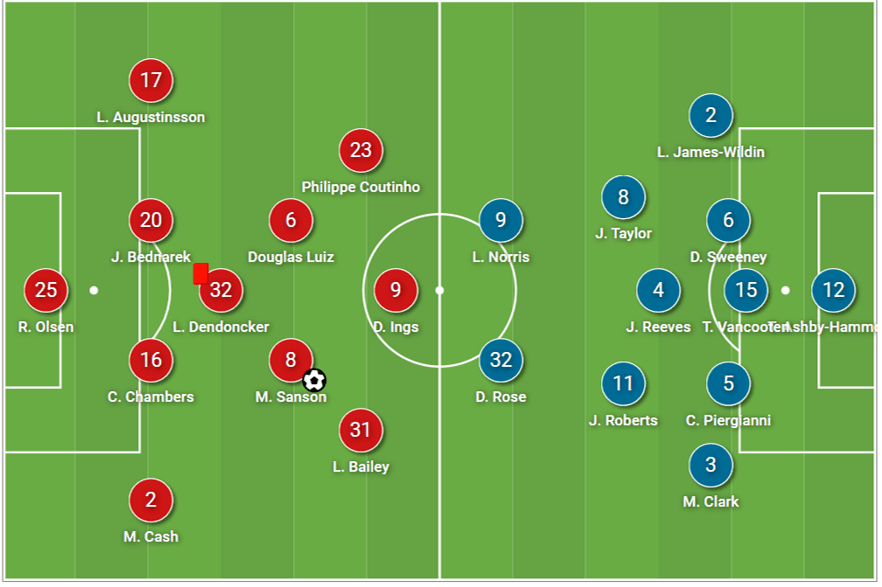
Stevenage boss Steve Evans set his side up in a 5-3-2 formation with the aim of soaking up pressure and utilising attacking transitions. This isn’t out of the ordinary for Evans’ men as they deploy this formation in league fixtures, but of course, the emphasis on defending was more so than usual. Villa dominated large portions of this game, registering 79% possession and over 500 passes more than Stevenage, but this isn’t something totally alien to the League Two promotion hopefuls. This season in League Two, Evans’ side has averaged less possession and passes than their opponent so far.
In terms of names, there was just one change in the starting 11 from their previous league game – a 1-0 victory over Gillingham. That change came in midfield, with Jake Taylor coming into the side, replacing Alex Gilby. Interestingly, both goals came from the bench, with substitutes Dean Campbell and Jamie Reid grabbing the goals that made history for their club.
Villa’s attacking approach vs Stevenage’s defensive setup
A strong lineup from Villa and a good grip on possession were not enough for Emery’s side to pose a huge threat to the Stevenage back line. How can a team three leagues above their opponent have 79% possession but only score once? Well, just by scratching at the surface, we can get a sense of Villa’s struggle in attack. Three shots on target out of a total of 17 is not great, and it explains why their xG was just 1.39 (Stevenage’s xG was 1.11). Furthermore, their average shot distance registered at 22.67 yards, suggesting that they struggled to break through a resolute Stevenage setup. This segment will look at the tactics of both sides – Villa’s attack and Stevenage’s defensive shape, and how they impacted the game.
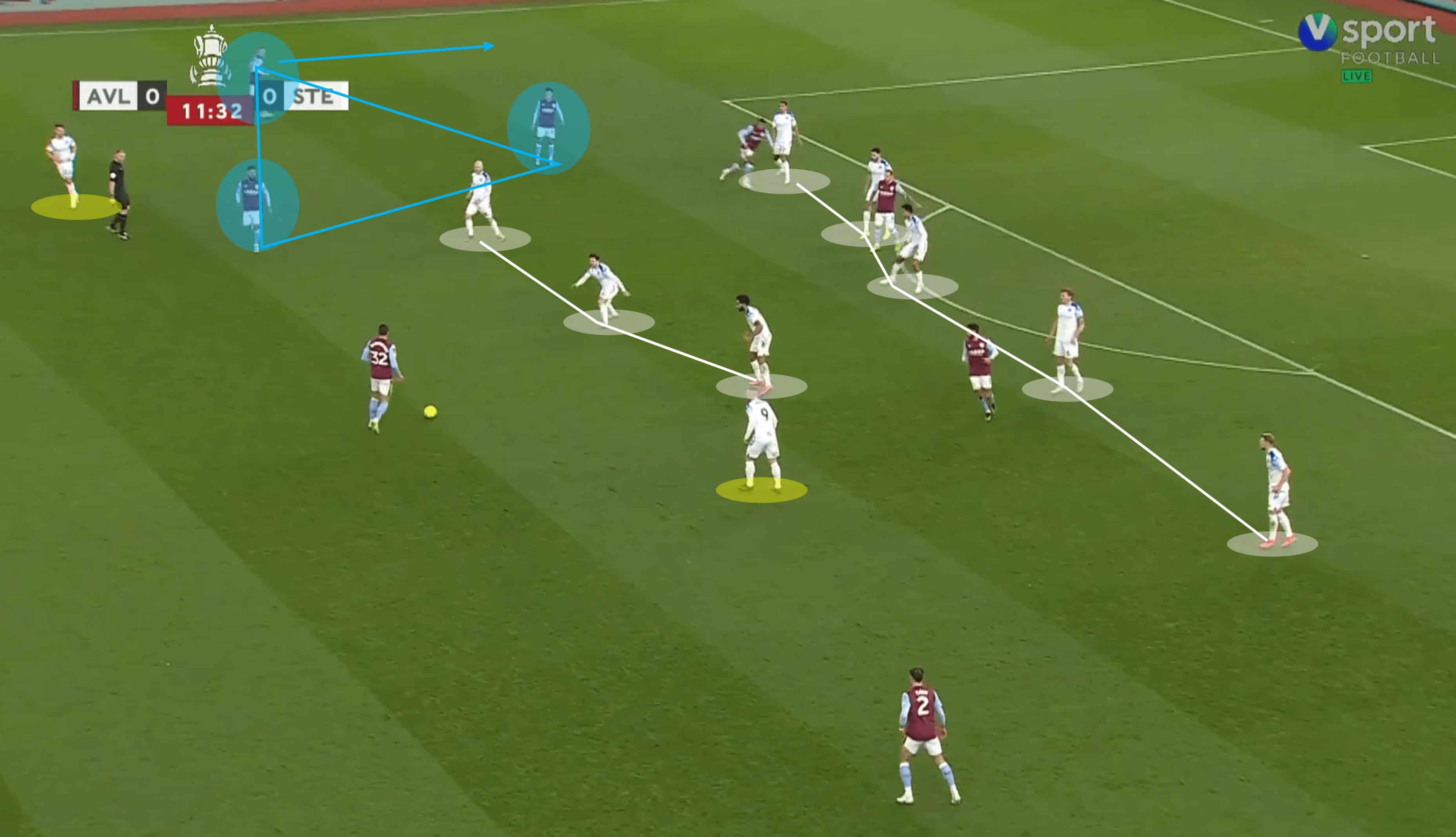
It may not come as a surprise to see Stevenage set up like they are above – a compact back five with good defensive presence from the midfielders and even the (yellow highlighted) forwards; all 10 men packed into their own half. A team that is used to sacrificing the larger portion of possession are likely to be well-drilled defensively, and Stevenage gave a strong account of that in this fixture. They didn’t simply sit back, they set themselves up accordingly, with good depth and width, with players doing well with their individual jobs.
The analysis image above also gives us an idea of what Villa looked to do on the ball to combat Stevenage’s stubborn defence. They looked to utilise the wide areas, with the League Two club seemingly happy to give that space up when Villa had the ball in central areas. Notice Villa’s presence on the left flank – they often looked for an overload such as this to get down the flank before either working the ball back inside in dangerous areas or floating a cross into the box.
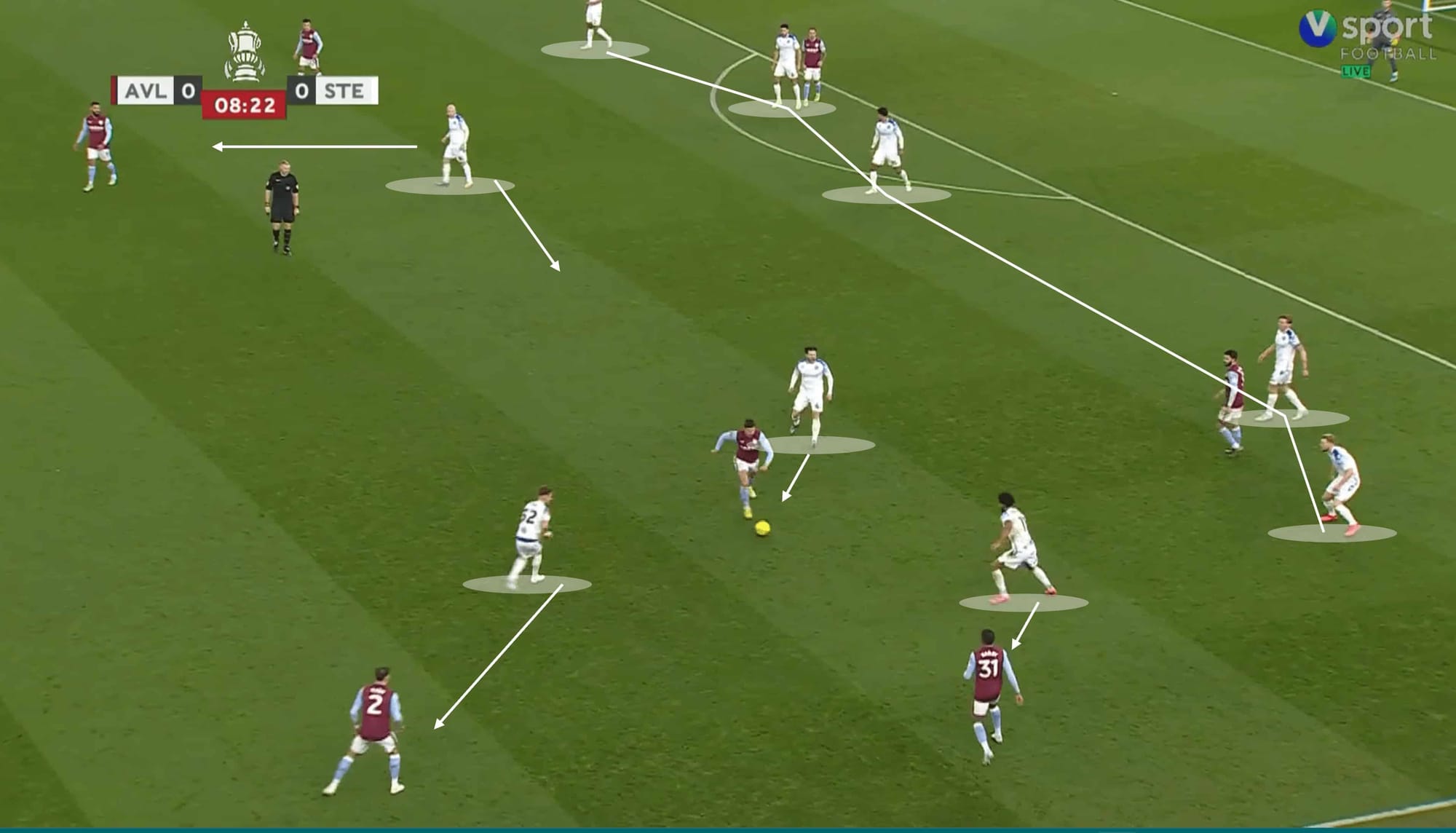
Being tactically fluid and flexible is important out of possession as well as on the ball, and Stevenage used this to good gain against Villa. Without compromising their defensive line; remaining virtually at the same depth, they would use certain triggers from Villa to widen their shape in both defence and midfield, slowly but eventually choking Villa’s possession. These triggers were often similar to the typical pressing triggers – poor pass, poor touch, the player on the ball turning to face his own goal, or a backward pass. This system played a big part in upsetting any rhythm that Villa were looking to put together, and limited their chances of creating good attacking opportunities deep in the final third.
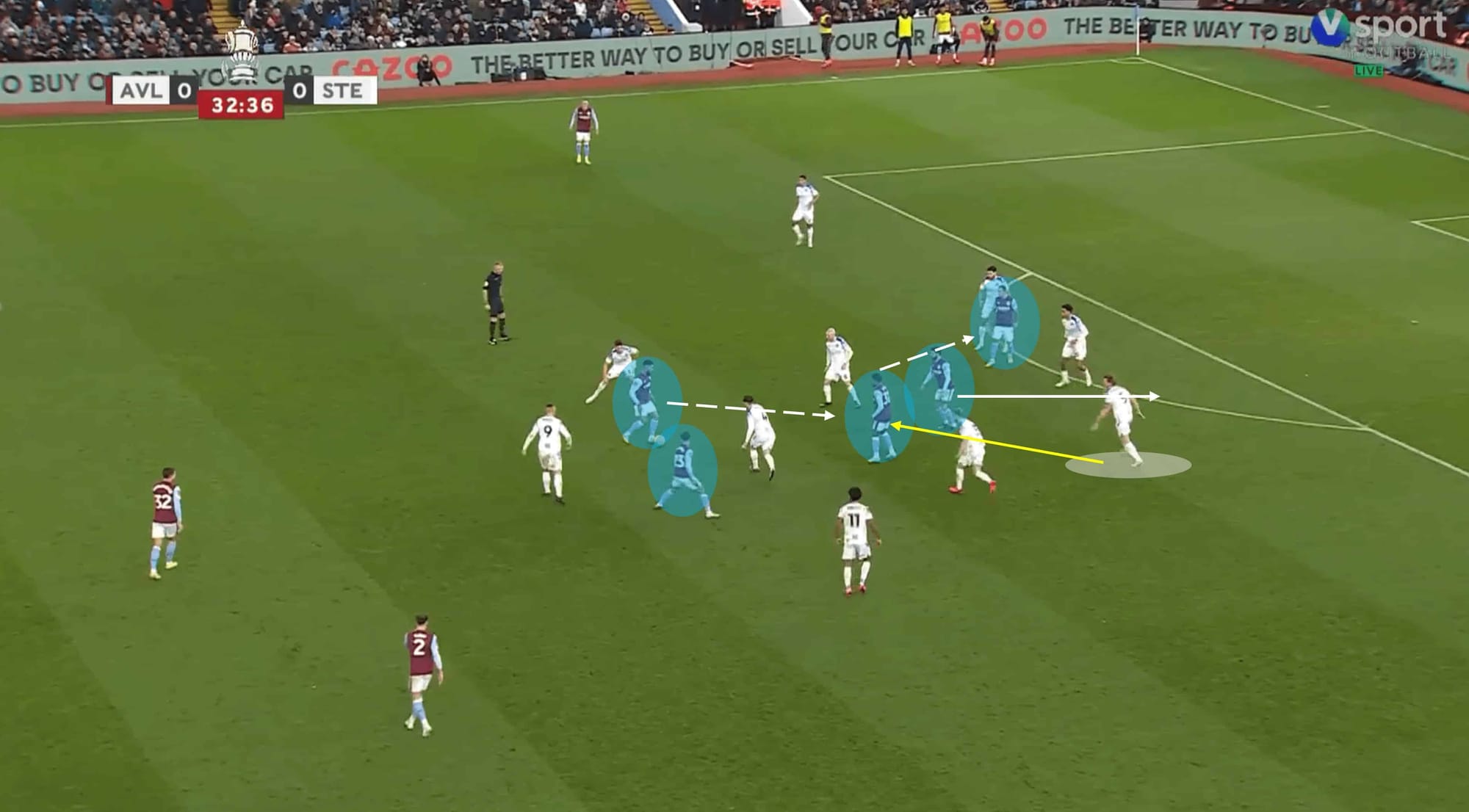
Despite Villa’s focus on the flanks, they too showed some tactical flexibility with the odd focus on central play, which is exactly where their goal originated from. It is not often you see so many players packed into one space so tightly in a game of football – five Villa players are present in that central space, and one of the Stevenage back-line even had to leave his post to give some assistance to the midfielders who looked to combat the Villa attack.
But the resulting action to Villa’s aim to penetrate through the middle highlighted the difference in quality, to a degree. A couple of quickly played passes through the swarm of bodies saw the ball bypass Sansone and make its way to the feet of Danny Ings. Now, composure and focus at this moment from Stevenage were key to defending this attack, but one player thought he saw the opportunity to halt the move altogether.
Stevenage’s number five, Carl Piergianni, who actually gave a strong performance over the 90+ minutes, found himself at fault this time. As the ball was passed through the cluster of boots in that small space, it found Leon Bailey, who was the man who bounce the ball off to Ings. However, as the ball reached Bailey, Piergianni saw what he thought was the perfect chance to step in and steal the ball – this didn’t go to plan and Sansone made a run into the space vacated by the Stevenage defender, leaving him in a dangerous area…
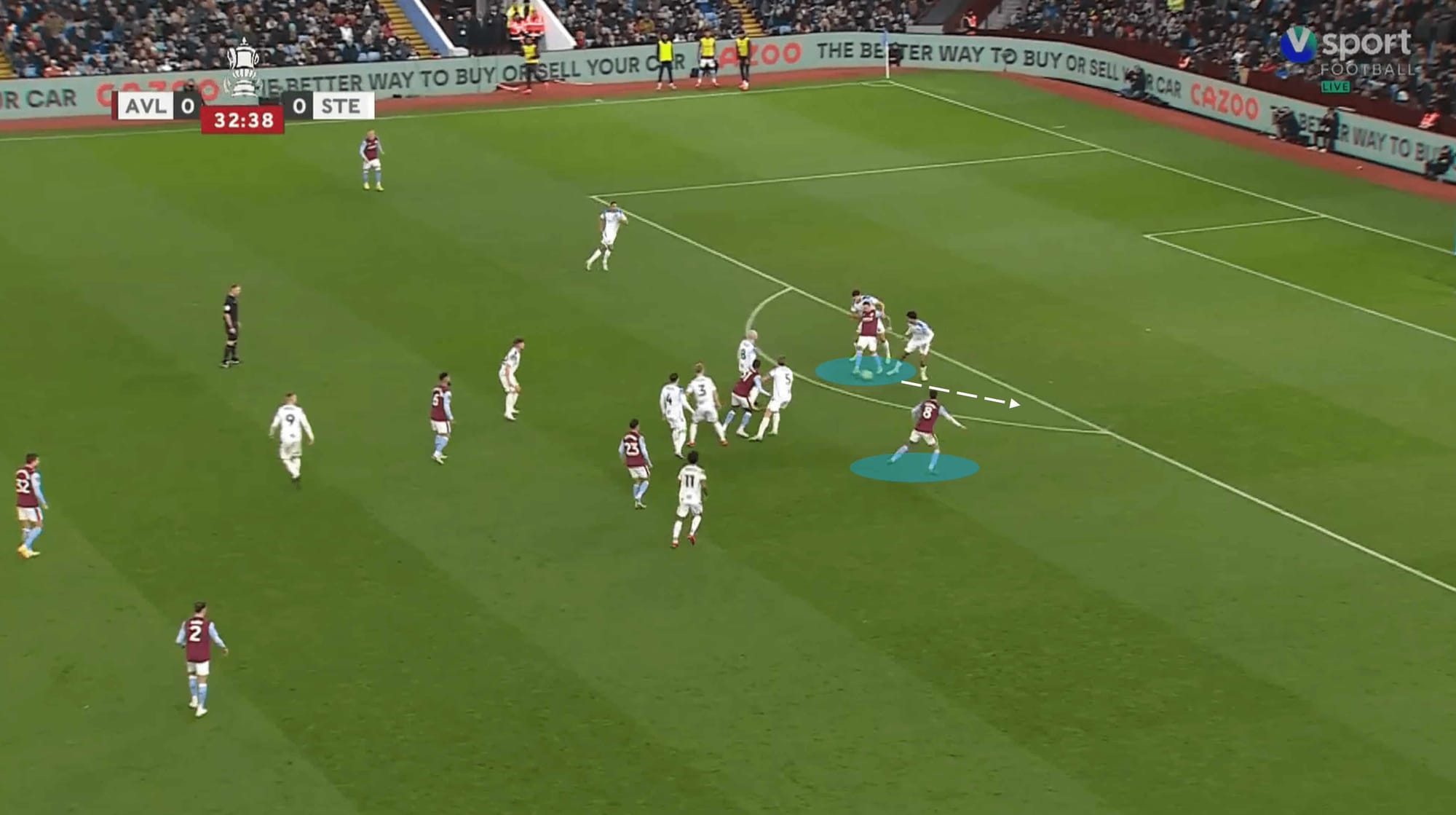
In the blink of an eye, Stevenage went from being an organised unit to one of chaos with poor positioning. Ings showed good game understanding to shield the ball as it arrived to him before playing a first-time pass to Sansone, who had cleverly moved into the open space. He took the ball well and showed good composure to slot the ball home.
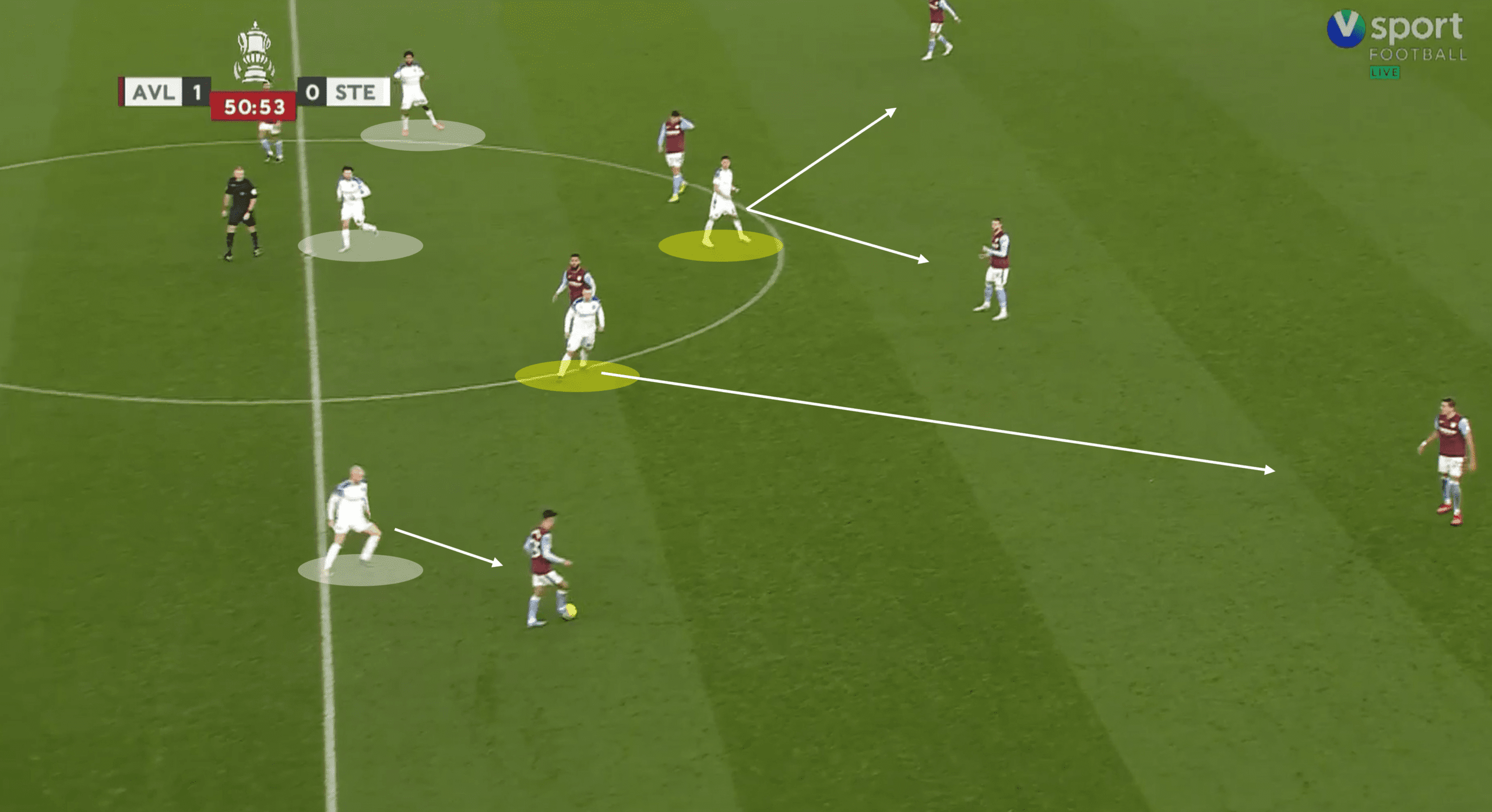
In the second half, Steve Evans’ team began to show more confidence in defending higher up and pressing Villa when they saw fit. This didn’t rock Villa completely at first but gave the game a new dimension. It seemed as though Stevenage’s theory was to allow their midfield to press and defend higher, with assistance from the wing-backs.
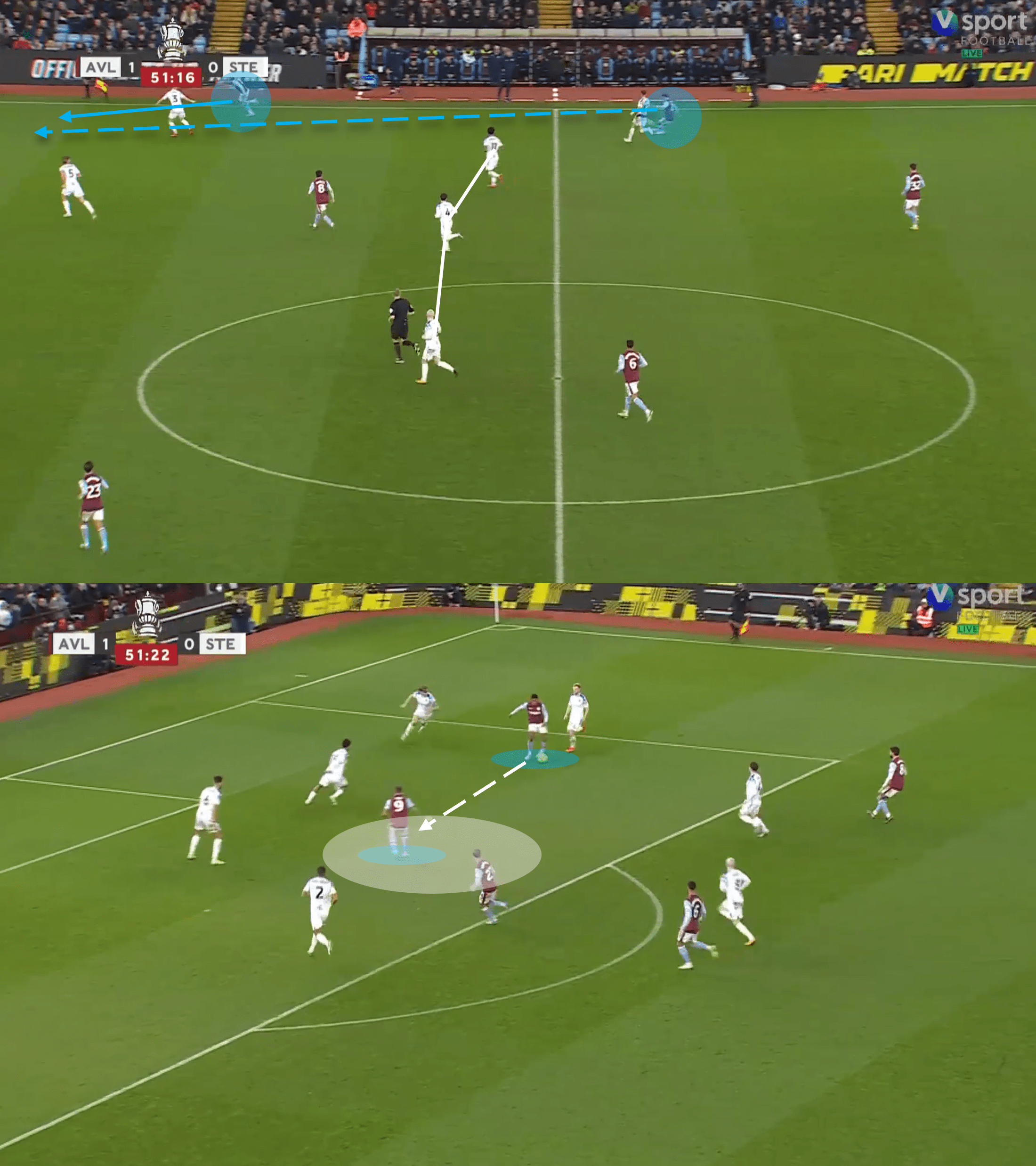
Stevenage’s tweak in defensive tactics resulted in an alteration in Villa’s approach play too. With less time on the ball than in the first half, they were forced to think quicker, which sounds like a curse, but would have been a blessing if they were more clinical and sharper on the day. With a player like Bailey on the flank who possesses frightening pace, he was Villa’s key to a quick attack on more than one occasion.
The higher full-backs of Stevenage meant that there was space in behind them to exploit; Villa failed to utilise this enough to make it really count, but it provided some chances for the Premier League club to cause damage. Bailey did well to bring the ball under control and wrong-foot Piergianni to cut inside from the right, before laying the ball off to Ings. Ings’ initial movement to lose his marker was trademark Danny Ings, but the action that followed was anything but that. Instead of shaping up to strike the ball first time, he looked as though he wanted to kill the ball dead or control it and turn out in the opposite direction. Stevenage’s good reaction and unit recovery meant that Ings was quickly swarmed and the attack was killed.
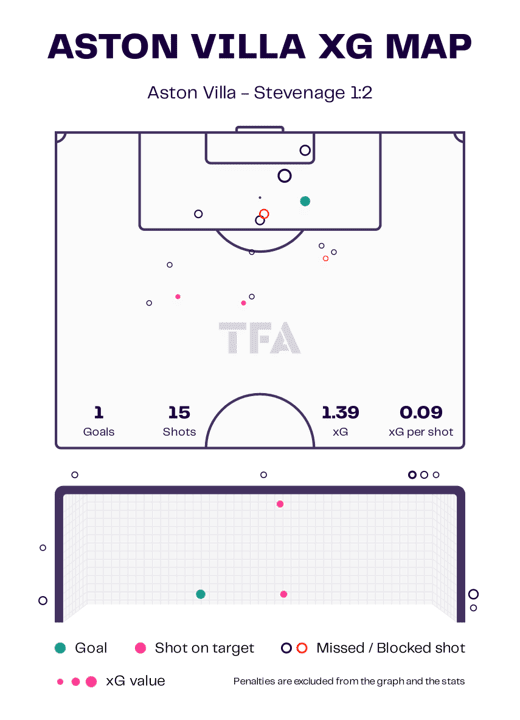
We touched upon Villa’s number of shots earlier, but this xG map gives us a stronger idea of how dangerous they were (or weren’t ). They managed just one shot on target from inside the box all game, and that was Sansone’s goal! Furthermore, Emery’s side had more attempts from range than inside the box (nine outside the box, six inside), with just two of those hitting the target.
What Stevenage did with their limited possession
Looking back, based on Villa’s overall performance on the day, there’s a chance that Stevenage could’ve taken the game to Villa slightly more, but they placed their faith in their defensive basis, as they knew that keeping Villa from creating good chances would, in turn, give Stevenage their best chance of hurting their opponent. They didn’t see much of the ball over the 90 minutes, 21% possession in fact, but they seemed to have plans in place for when they did have the ball.
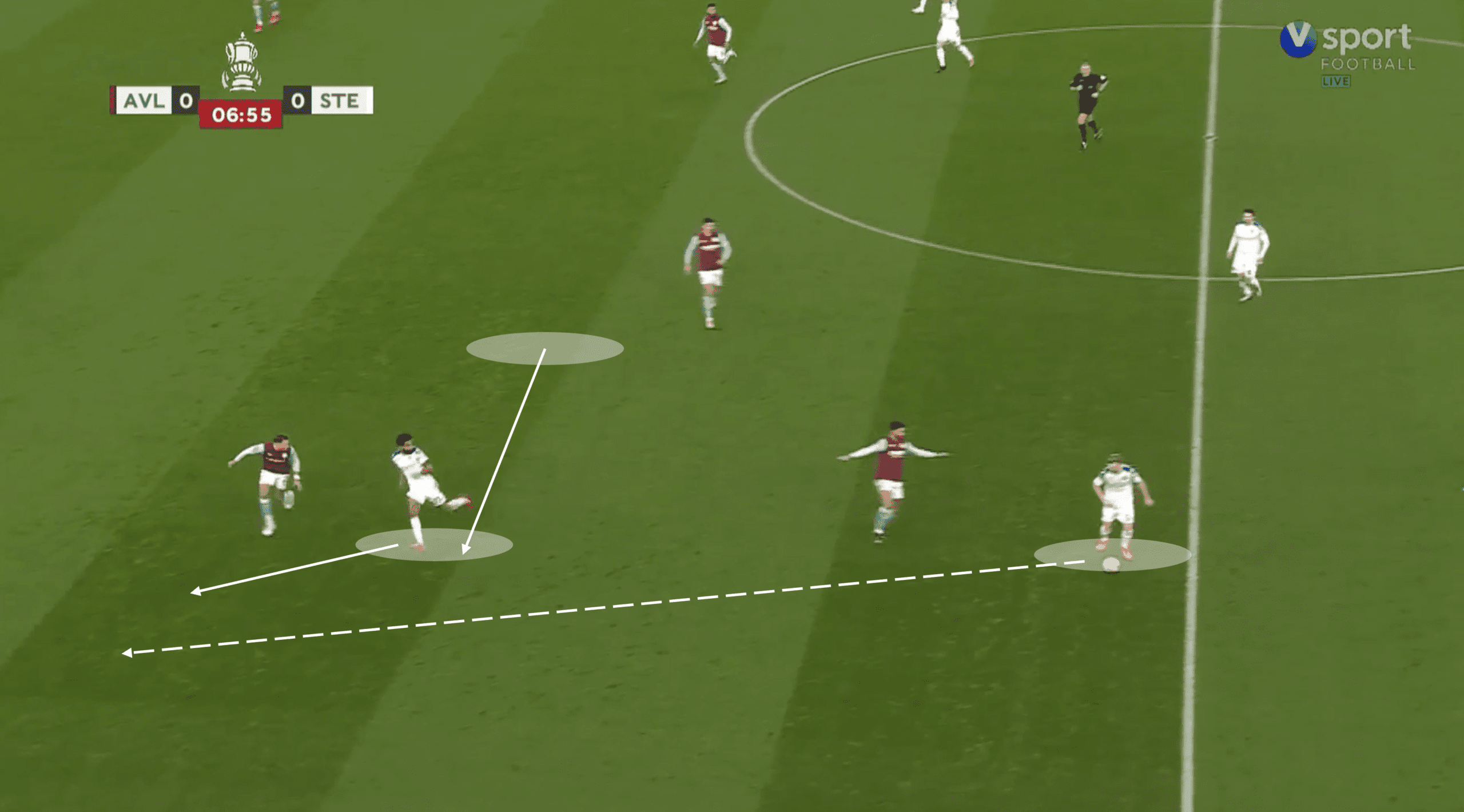
Spells of sustained possession were not going to be a regular feature of Stevenage’s performance on this occasion, and they knew this. So, that left them capitalising on transitions and turnovers. The example above shows us what they looked to primarily – hit the flanks with the aim of getting a corner kick or a throw-in high up the pitch, as these would give them a chance to get players into the box and attack Villa.
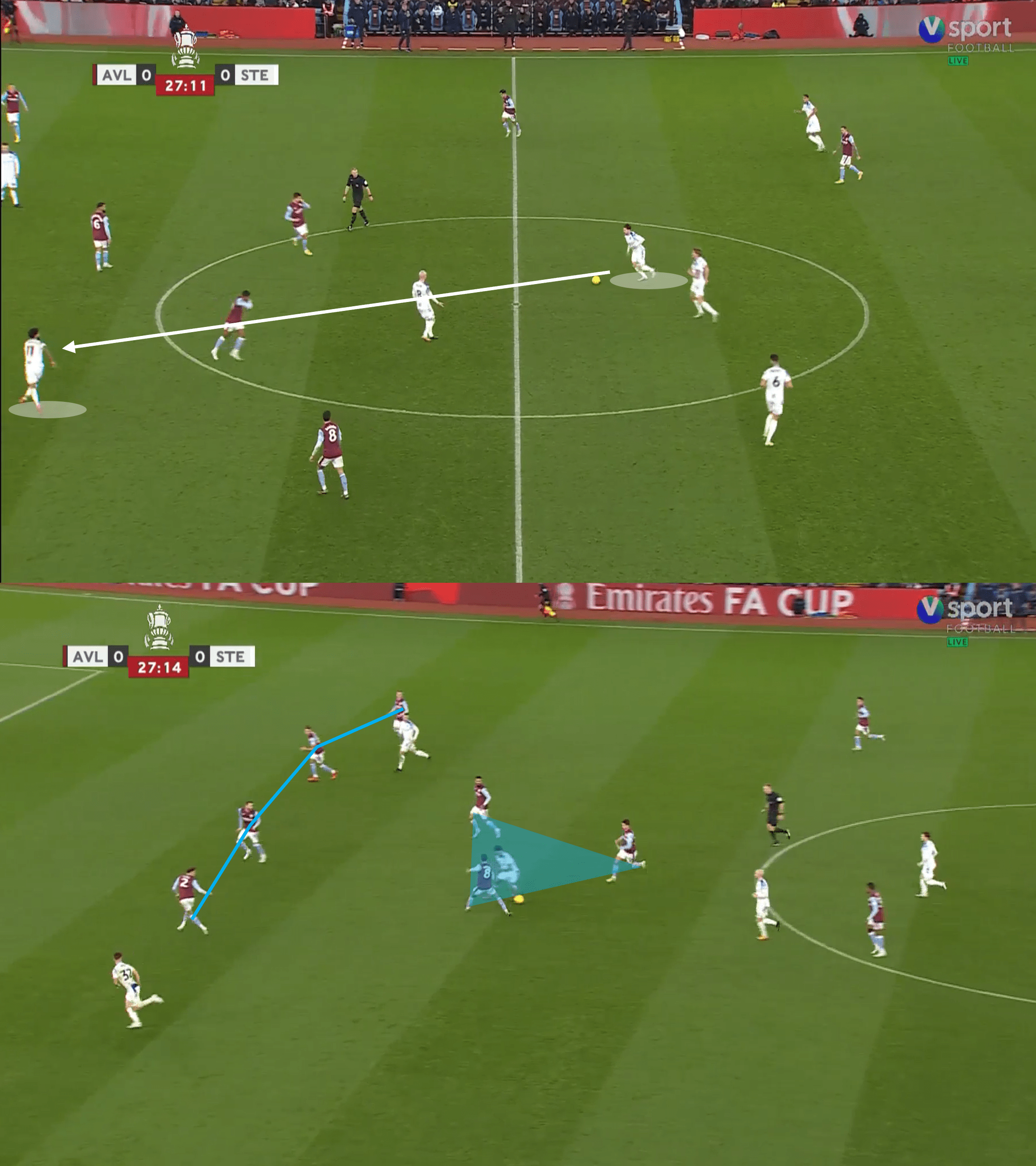
Like Villa, Stevenage also occasionally switched their focus to try and penetrate central areas. The difference was, Stevenage had less of everything really – fewer attacks, fewer chances, fewer players forward, and less time to choose their next move, so a lot of their play really was just to play the first pass they saw and play quickly.
This caught Villa’s midfield out initially in the image above, with a line-breaking pass giving Stevenage a sniff of going at their opponents. But a first touch that wasn’t the greatest gave Villa’s midfield three the chance to recover the regain their shape to protect their back four.
Stevenage pounce amid Villa’s collapse
We’ve had some incredible FA Cup giant-killer stories over the years, but few match the late drama of this one. Villa went from 1-0 up in the 85th minute to being 2-1 down with 10 men by the time the fourth official held up his board to indicate the number of added minutes. While credit should go to Stevenage, Aston Villa also have themselves to blame as the warning signs were there in the way that Stevenage defended and pressed higher and higher as the game progressed, but Villa failed to adapt accordingly, and it cost them.
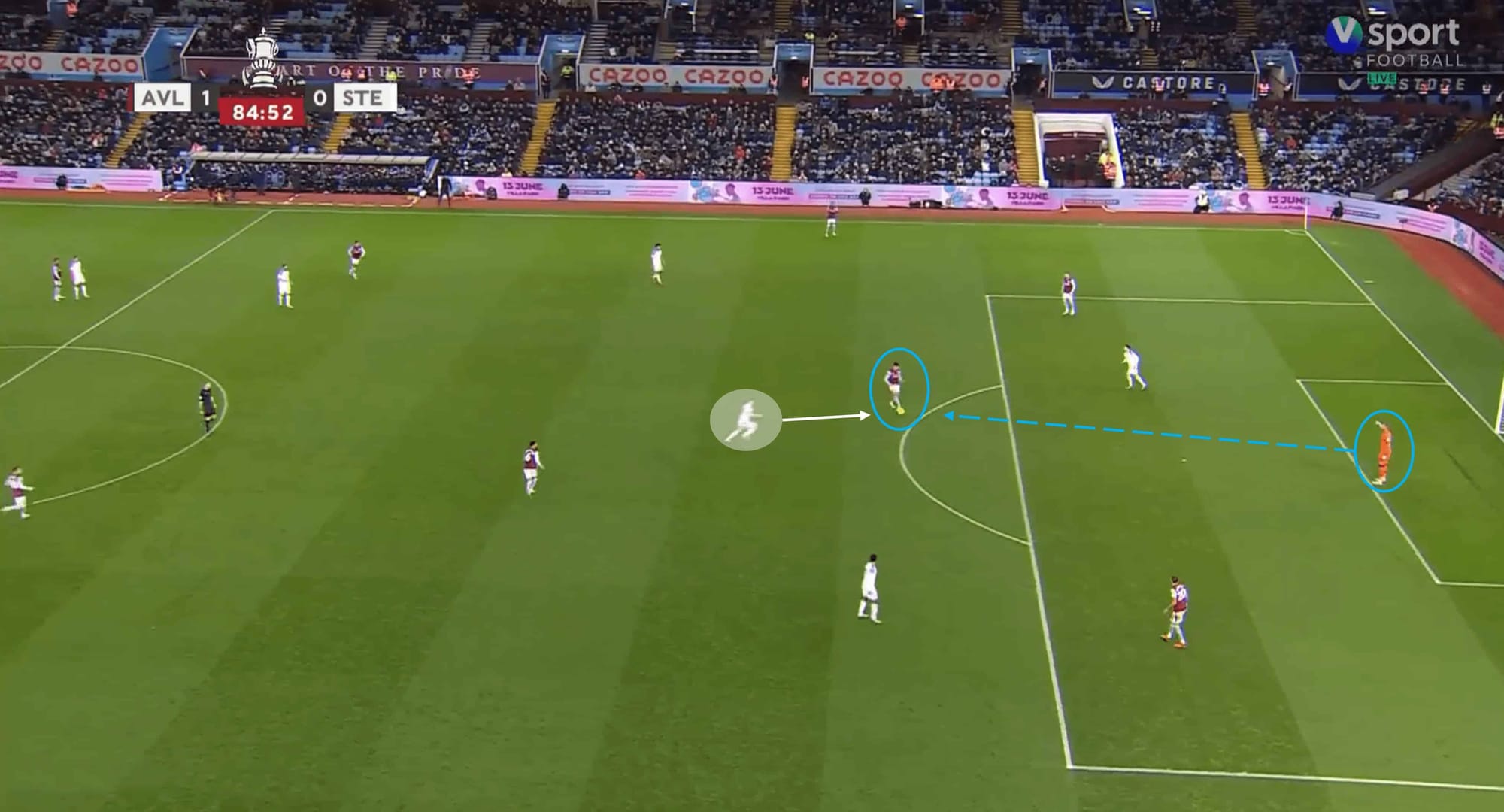
This. This is the moment that truly started the heroic comeback and sent Stevenage fans into a frenzy. Villa, to their credit, tried sticking to their game plan of patient build-up play, which sometimes included playing out from the back. They may have gotten away with it too if it wasn’t for Dendoncker being far too casual when receiving the ball from Olsen.
He is quickly pressed and dispossessed by Stevenage number 10 Dean Campbell, and that’s where the panic sets in the for Villa man. Dendoncker pulls at Campbell’s shirt before bringing him down, and a lengthy VAR check decided that it should be a Stevenage penalty. To make matters worse, Dendoncker saw red for his challenge. The penalty was coolly dispatched and Stevenage resumed the game with a new, refreshed energy.
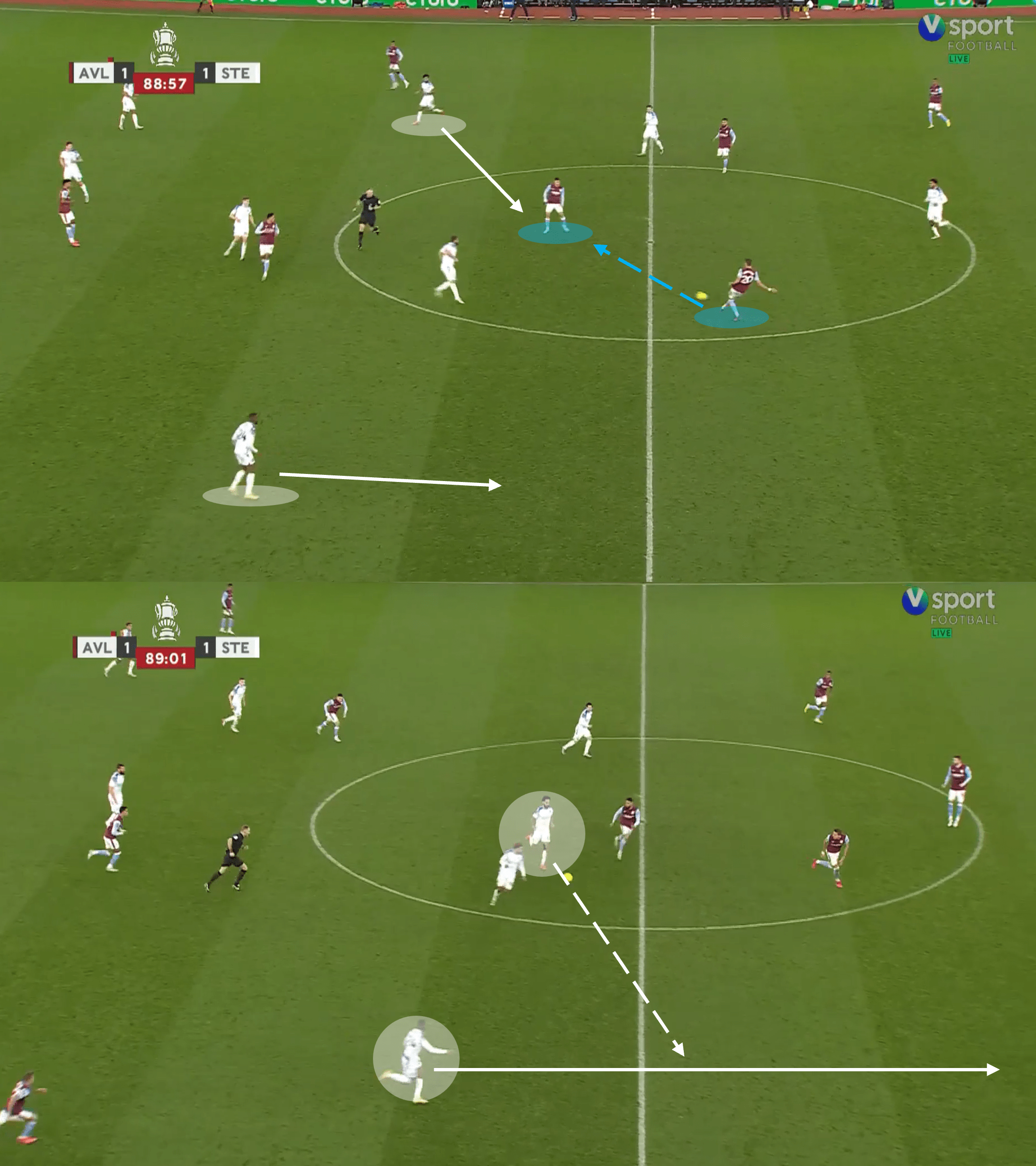
You’d think Villa would learn, wouldn’t you? They had just been punished by being too relaxed on the ball and not being aware of their surroundings, and lightning struck twice as Stevenage steal the ball in midfield and send the ball into the path of David Amoo who carries the ball all the way towards the byline before his cross is blocked and the ball goes out for a Stevenage corner.
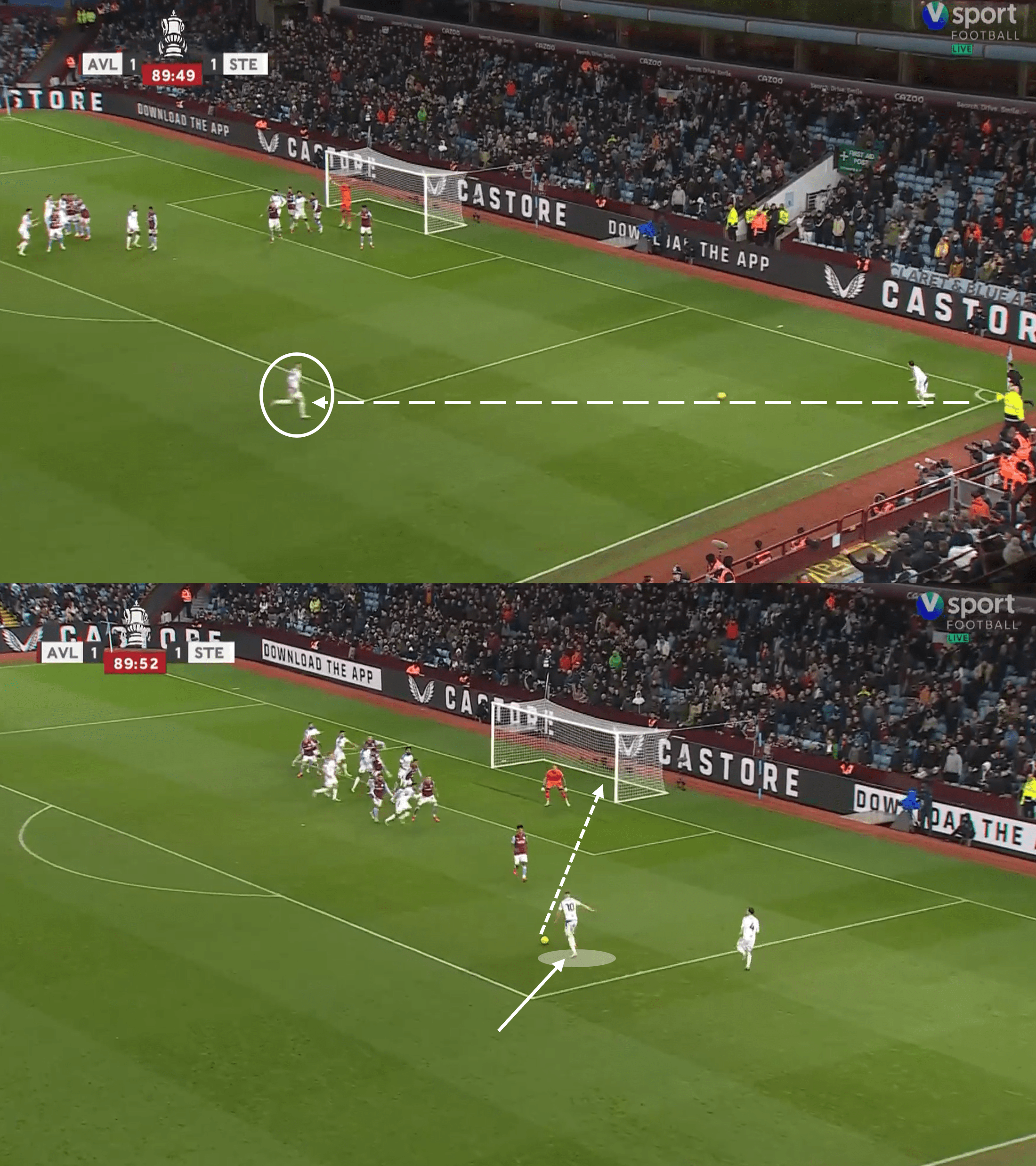
Shades of Divock Origi versus Barcelona as the Stevenage corner was taken quickly, with Villa sleeping again. Dean Campbell, who had just made an impact off the bench by winning his team a penalty, collects the ball from a short corner, with all the space he could ever dream of. He is allowed to drive into the box at an angle before Villa react, but it is far too late and Campbell strikes the ball as soon as a player tries to close him down. His powerful near-post effort beats Olsen and etches Campbell’s name into Stevenage folklore forever.
Conclusion
Aston Villa started somewhat brightly and showed glimpses of what they wanted from their game plan in how they kept the ball for such a large portion of the game. But all they provided was another piece of evidence for the case of “possession isn’t everything in football”. They failed to make any real impact inside the box, with a lack of creativity, movement, and sharpness to blame – Stevenage’s defensive performance too.
Steve Evans will be immensely proud, not only of the result but the performance too. His team did what he asked and defended with courage and tactical understanding, and they got their reward late on.

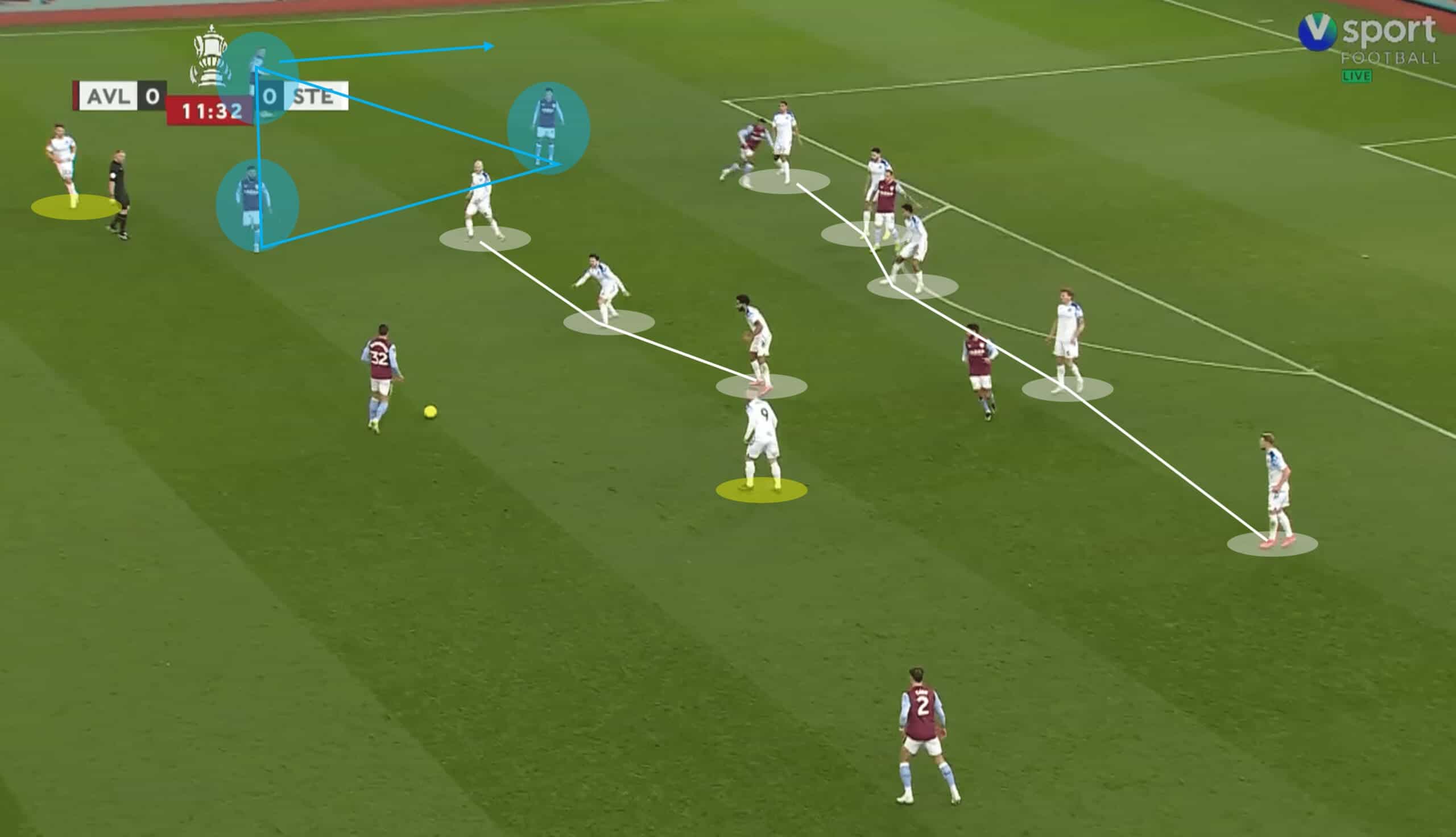




Comments